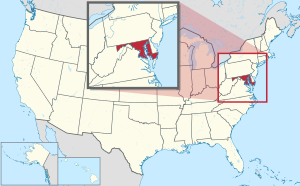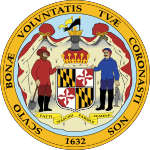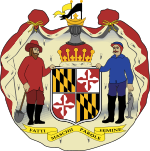
Back Maryland Afrikaans ሜሪላንድ Amharic Maryland AN Marianland ANG ماريلند Arabic ܡܐܪܝܠܐܢܕ ARC ميريلاند ARY ماريلاند ARZ Maryland AST Maryland suyu Aymara
Maryland | |
|---|---|
| Nicknames: | |
Mottoes:
| |
 Location of Maryland within the United States | |
| Country | United States |
| Before statehood | Province of Maryland |
| Admitted to the Union | April 28, 1788 (7th) |
| Capital | Annapolis |
| Largest city | Baltimore |
| Largest county or equivalent | Montgomery |
| Largest metro and urban areas |
|
| Government | |
| • Governor | Wes Moore (D) |
| • Lieutenant Governor | Aruna Miller (D) |
| Legislature | General Assembly |
| • Upper house | Senate |
| • Lower house | House of Delegates |
| Judiciary | Supreme Court of Maryland |
| U.S. senators | |
| U.S. House delegation |
|
| Area | |
• Total | 12,407 sq mi (32,133 km2) |
| • Land | 9,776 sq mi (25,314 km2) |
| • Water | 2,633 sq mi (6,819 km2) 21% |
| • Rank | 42nd |
| Dimensions | |
| • Length | 250 mi (400 km) |
| • Width | 100 mi (200 km) |
| Elevation | 350 ft (110 m) |
| Highest elevation | 3,360 ft (1,024 m) |
| Lowest elevation | 0 ft (0 m) |
| Population (2024) | |
• Total | |
| • Rank | 18th |
| • Density | 632/sq mi (244/km2) |
| • Rank | 5th |
| • Median household income | $98,700 (2023)[7] |
| • Income rank | 3rd |
| Demonym | Marylander |
| Language | |
| • Official language | None (English, de facto) |
| Time zone | UTC−05:00 (Eastern) |
| • Summer (DST) | UTC−04:00 (EDT) |
| USPS abbreviation | MD |
| ISO 3166 code | US-MD |
| Traditional abbreviation | Md. |
| Latitude | 37° 53′ N to 39° 43′ N |
| Longitude | 75° 03′ W to 79° 29′ W |
| Website | maryland |
| List of state symbols | |
|---|---|
 | |
 | |
 | |
| Song | None. Formerly: "Maryland, My Maryland" by James Ryder Randall (1861), (adopted 1939, repealed 2021) |
| Living insignia | |
| Bird | Baltimore oriole |
| Cat breed | Calico cat |
| Crustacean | Blue crab |
| Dog breed | Chesapeake Bay Retriever |
| Fish | Rock fish |
| Flower | Black-eyed Susan |
| Horse breed | Thoroughbred |
| Insect | Baltimore checkerspot butterfly |
| Reptile | Diamondback terrapin |
| Tree | White oak |
| Inanimate insignia | |
| Beverage | Milk |
| Dance | Square dance |
| Dinosaur | Astrodon johnstoni |
| Food | Smith Island cake |
| Fossil | Ecphora gardnerae gardnerae |
| Gemstone | Patuxent River stone |
| Ship | Skipjack |
| Sport | |
| State route marker | |
 | |
| State quarter | |
 Released in 2000 | |
| Lists of United States state symbols | |
Maryland (US: /ˈmɛrɪlənd/ ⓘ MERR-il-ənd)[b] is a state in the Mid-Atlantic region of the United States.[9][10] It borders the states of Virginia to its south, West Virginia to its west, Pennsylvania to its north, Delaware and the Atlantic Ocean to its east, and the national capital and federal district of Washington, D.C. to the southwest. With a total area of 12,407 square miles (32,130 km2), Maryland is the ninth-smallest state by land area,[11] and its population of 6,177,224 ranks it the 18th-most populous state and the fifth-most densely populated. Maryland's capital city is Annapolis, and the most populous city is Baltimore.[12]
Maryland's coastline was first explored by Europeans in the 16th century. Prior to that, it was inhabited by several Native American tribes, mostly the Algonquian peoples.[13] As one of the original Thirteen Colonies, Maryland was founded by George Calvert, 1st Baron Baltimore, a Catholic convert[14][15] who sought to provide a religious haven for Catholics persecuted in England.[16] In 1632, Charles I of England granted Lord Baltimore a colonial charter, naming the colony after his wife, Henrietta Maria.[17] In 1649, the Maryland General Assembly passed an Act Concerning Religion, which enshrined the principle of toleration.[18] Religious strife was common in Maryland's early years, and Catholics remained a minority, albeit in greater numbers than in any other English colony. Maryland's early settlements and population centers clustered around waterways that empty into the Chesapeake Bay. Its economy was heavily plantation-based and centered mostly on the cultivation of tobacco. Demand for cheap labor from Maryland colonists led to the importation of numerous indentured servants and enslaved Africans. In 1760, Maryland's current boundaries took form following the settlement of a long-running border dispute with Pennsylvania. Many of its citizens played key political and military roles in the American Revolutionary War. Although it was a slave state, Maryland remained in the Union during the American Civil War, and its proximity to Washington D.C. and Virginia made it a significant strategic location. After the Civil War ended, Maryland took part in the Industrial Revolution, driven by its seaports, railroad networks, and mass immigration from Europe.
Since the 1940s, the state's population has grown rapidly, to approximately six million residents, and it is among the most densely populated U.S. states. As of 2015[update], Maryland had the highest median household income of any state, owing in large part to its proximity to Washington, D.C., and a highly diversified economy spanning manufacturing, retail services, public administration, real estate, higher education, information technology, defense contracting, health care, and biotechnology.[19] Maryland is one of the most multicultural states in the country; it is one of the six states where non-Whites compose a majority of the population, with the fifth-highest percentage of African Americans, and high numbers of residents born in Africa, Asia, Central America, and the Caribbean. The state's central role in U.S. history is reflected by its hosting of some of the highest numbers of historic landmarks per capita.
The western portion of the state contains stretches of the Appalachian Mountains, the central portion is primarily composed of the Piedmont, and the eastern side of the state makes up a significant portion of Chesapeake Bay. Sixteen of Maryland's twenty-three counties, and the city of Baltimore, border the tidal waters of the Chesapeake Bay estuary and its many tributaries,[20][12] which combined total more than 4,000 miles of shoreline. Although one of the smallest states in the U.S., it features a variety of climates and topographical features that have earned it the moniker of America in Miniature.[21] In a similar vein, Maryland's geography, culture, and history combine elements of the Mid-Atlantic, Northeastern, and Southern regions of the country.
- ^ "Maryland's quality of life ranks high compared to other states". The Daily Record. July 1, 2021. Archived from the original on October 22, 2023. Retrieved September 30, 2023.
- ^ "Maryland Facts". Maryland Office of Tourism. Archived from the original on June 13, 2010. Retrieved June 2, 2009.
- ^ "Senate Bill 88" (PDF). Archived from the original (PDF) on September 29, 2017.
- ^ "Great Seal of Maryland (reverse)". Maryland State Archives. Archived from the original on January 4, 2013. Retrieved March 4, 2014.
- ^ a b "Elevations and Distances in the United States". United States Geological Survey. 2001. Archived from the original on October 15, 2011. Retrieved October 21, 2011.
- ^ "United States Census Quick Facts Maryland". Retrieved January 3, 2025.
- ^ "Household Income in States and Metropolitan Areas: 2023" (PDF). Retrieved January 12, 2025.
- ^ Wells, John C. (2008). Longman Pronunciation Dictionary (3rd ed.). Longman. ISBN 978-1-4058-8118-0.
- ^ "Mid-Atlantic Home : Mid–Atlantic Information Office". U.S. Bureau of Labor Statistics. Archived from the original on April 8, 2019. Retrieved July 27, 2017.
- ^ "United States Regions". National Geographic Society. January 3, 2012. Archived from the original on November 28, 2021. Retrieved November 19, 2021.
- ^ "Maryland - 2023 - III.B. Overview of the State". mchb.tvisdata.hrsa.gov. Archived from the original on January 3, 2024. Retrieved January 3, 2024.
- ^ a b "Baltimore". Encyclopædia Britannica. June 18, 2023. Archived from the original on July 19, 2019. Retrieved April 25, 2019.
- ^ "People, Tribes and Bands". Maryland Manual On-line: A Guide to Maryland and its Government. Maryland State Archives. Archived from the original on July 17, 2019. Retrieved August 25, 2019.
- ^ "George Calvert and Cecilius Calvert, Barons Baltimore" William Hand Browne, Nabu Press (August 1, 2010), ISBN 117662539X ISBN 978-1176625396
- ^ Krugler, John D. (2004). English and Catholic : the Lords Baltimore in the seventeenth century. Baltimore: Johns Hopkins University Press. ISBN 978-0801879630. OCLC 53967315.
- ^ Andrews, Matthew Page (1929). History of Maryland: Province and State. Garden City, New York: Doubleday, Doran & Company, Inc. pp. 3–5.
- ^ "The Charter of Maryland : 1632". avalon.law.yale.edu. December 18, 1998. Archived from the original on March 25, 2015. Retrieved May 2, 2018.
- ^ "Avalon Project—Maryland Toleration Act; September 21, 1649". avalon.law.yale.edu. Archived from the original on November 25, 2009. Retrieved May 3, 2018.
- ^ "State Median Household Income Patterns: 1990–2010". U.S. Census Bureau. Archived from the original on October 26, 2011. Retrieved August 6, 2012.
- ^ Tom Horton; William Chesapeake Bay Foundation (2013). Turning the Tide: Saving the Chesapeake Bay. Island Press. p. 221. ISBN 9781610911160.
- ^ "Maryland Facts". Visit Maryland. Archived from the original on April 25, 2019. Retrieved April 25, 2019.
Cite error: There are <ref group=lower-alpha> tags or {{efn}} templates on this page, but the references will not show without a {{reflist|group=lower-alpha}} template or {{notelist}} template (see the help page).

